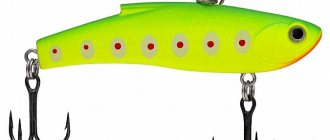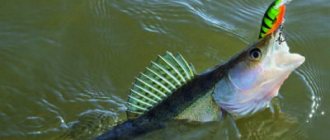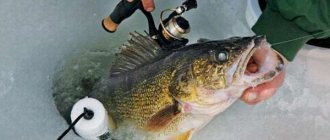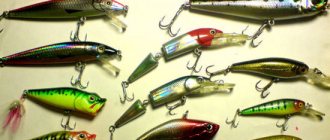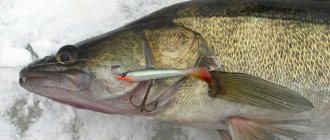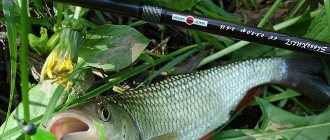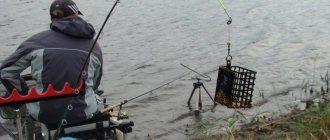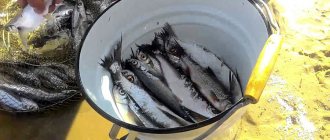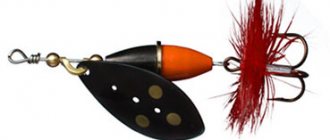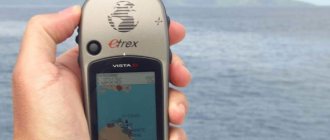Fishing for sabrefish
This fish is of medium and clear (without dense thickets) water. That is, it is not at the surface and not near the bottom. Let's say, if the depth at the fishing point is about 5 meters, then the saber fish will be in a layer of mainly 2-4 meters. Therefore, it is undesirable to catch sabrefish where the depth is less than about 3 meters. If there is anything there, it will be mostly trivial.
You can use any cheap store-bought bait, or even just ground crackers. I add large fractions to the bait. As a rule, this is steamed pearl barley. (This is not necessary, but I think it's better this way). The bait must be prepared with such a viscosity that the feeder is unloaded before it falls to the bottom. That is, the viscosity should be minimal, until the first signs of sticking. As soon as you touch it with your finger, the lump of bait crumbles into dust. When filling the feeder with such bait, I compact it “as hard as I can.” As a result, the feeder is completely unloaded at a depth of 2-3 meters, small fractions create a trail, and pearl barley grains slowly settle to the bottom.
I control the process as follows. For feeding I use cylindrical feeders with a volume of 90 cubic meters. cm with a load of 10-16 grams. The curb weight of such a feeder is about 100 grams, and its sinking speed is approximately 0.3 m/sec. When the feeder is immersed after casting, the cord is stretched and the quivertip is initially noticeably bent. As the bait is washed out, the weight of the feeder decreases, and its windage increases. The immersion speed decreases, the cord weakens and the quiver tip almost straightens. This is hard to see on a fast action rod, but is clearly visible if the rod has a parabolic action. If the quivertip almost straightens, somewhere around the 10th second (that is, at a depth of 2.5-3 meters), then this is what the doctor ordered. Thus, I throw up to half a kilogram of bait (5-6 casts).
I change the feeder to a less capacious one (30-40 cc) and, depending on the strength of the current, a heavier one. Based on the condition of the shore behind (presence of vegetation, etc.) and the depth at the fishing point, I attach a leash up to one and a half meters long. And on the shank of the hook there is a foam ball so that it keeps the hook with bait afloat. For bait I use either maggots or the same grains of steamed pearl barley. I make casts every 5 minutes.
Then everything depends on how far the flock of sabrefish was before feeding. If it is a few tens of meters from the fishing point, then it is already here. The sabrefish is a fast fish, scurrying here and there in search of food and approaches very quickly. Although it is not very large (it grows mainly up to 500 g), it is strong and decisive and therefore self-hooks when biting. Moreover, if the depth at the fishing spot is approximately 5 meters or more, then most bites occur even before the feeder sinks to the bottom - the feeder is still sinking, but the quivertip is already twitching. Chekhon is, in fact, a river herring and travels in schools in numbers slightly inferior to those shown in Cousteau’s films. So, the pleasure will last for a long time - there will be no time to smoke.
You can organize a family contract. One feeds a point at the bottom where he catches bottom fish, and 3-4 meters downstream (so that there are no overlaps) the second “for free” catches sabrefish without a feeder, but simply with a load.
Crucian carp on the feeder
This is not the kind of fish that, for safety reasons, tends to move further from the shore. After spawning, it spreads over the entire area of the reservoir, but prefers holes with a muddy bottom and changes in depth near thickets of grass and reeds, where it feeds and hides from predators. Catching crucian carp with a fly rod near the shore can be more effective than with a feeder in the middle of the river. However, the feeder (or picker) expands the possibilities. For example, on a narrow river it is not such a rare situation when you can accurately place the equipment under a solid wall of grass and reeds only from the opposite bank. And on our shore, from a small spot on the shore you can throw along the shore to the right or left under the thickets.
Crucian carp migrate reluctantly, especially if it is connected with access to clean water. Therefore, dusty bait may not give the desired effect. It is much better if the bait contains worms, maggots, bloodworms (chopped to enhance the smell) or appropriate flavorings. If the bottom is deep in silt (and how can you tell?), then it is advisable to prepare the bait in such a way that it is quickly washed out in the absence of a current in the silt or, if possible, feed it “by hand.” For the same reasons, the length of the leash should be at least 40-50 cm. Crucian carp is an omnivorous fish and practically the entire range of baits (attachments) used for peaceful fish is suitable as bait (attachments).
Circumstances when a feeder is simply necessary
Fishermen are familiar with the situation when the fish goes to depth, and it is impossible to cast a spinning rod far. A feeder helps out in such cases, especially if fishing is started in a densely overgrown reservoir. It is also indispensable when you need to throw bait into a hard-to-reach place in a reservoir. But this tackle is especially useful when catching predators in deep places, over 4-5 meters, where it is simply inconvenient to use a float. This happens in the fall, when predators descend to the lowest places in the reservoir. If fishing is for a predator, then you should take into account the fact that constant activity of the gear is needed, that is, its constant movement is required. Successful catching of a predator on a feeder directly depends on the factor of how quietly the bait is presented to the fish.
Perch on the feeder
If there is a perch in a pond, then it is everywhere. Sometimes it is enough to switch from a maggot to a worm so that only perch is caught - the peaceful fish does not even have time to sniff the bait. To enhance the effect and attract large perch, you need to add chopped worms or bloodworms to the bait, and bait the hook with a live bait no larger than your little finger by the lower lip. (In general, I think that when fishing with any bottom tackle, live bait should be hooked to the lower lip. This minimally restricts the movements of the live bait when the leash is below). The length of the leash is up to a meter.
To prevent the baitfish from tearing off its lip when casting, the cast must be done smoothly. Otherwise, the live bait and the equipment will fly separately. It is clear that with such a cast the range will be short - a maximum of 40 meters. For catching large perch, the most promising place is on the border of the algae, where it hides, waiting for prey.
Gear for catching a predator using a feeder: Feeder diagram for a predator + installation of feeder gear.
An attentive lover of fishing for peaceful fish paid attention and often at the point behind the stern of the place where white fish were caught. During the bite, pike, pike perch or perch bite on a live fish, like a train. Briefly, in those places where the fishing point has been fed, predatory fish approach.
The feeder for the predator is assembled using a simple feeder installation.
We use a round feeder and inside it there is a cable, which we connect to the main fishing line and attach a sinker with an anchor.
We attach a lead weight with an anchor directly from the bottom of the feeder feeder, and put the eye of the feeder itself on the main fishing line.
Then we put on a bead that protects our fishing knot near the swivel with a carabiner or clasp.
We knit a fishing knot for a swivel with a clasp, I advise you to read the article: Swivel knot for a swivel, “offshore swivel knot”.
How to set up a leash for live bait on a rig. Feeder for a predator.
You can use a tee with a cable purchased at a fishing store for live bait. This is the easiest option for fishing with live bait.
There is an option to knit it yourself from a braided cord using different fishing hooks: a tee hook, a double hook and a single hook for attaching live bait to the tackle. I advise you to read the article: How to properly attach a live bait to a leash with hooks?
The braided cord used for the leash allows you to catch a decent catch with live bait: Pike perch, Pike or large perch.
- We carefully look at the photo below and remember the diagram + installation of the feeder for a predator: pike perch, pike and large perch.
What role does the length of the leash and the fish hook play in tactics? I advise you to read the article: Feeder fishing tactics - which leash is more effective on the feeder.
Was the fishing information useful?
Subscribe to the fishing channel To read the news of the fishing channel Share the latest article
Pike on the feeder
If we have fed the point well and collected peaceful fish there, we can rest assured that there is also a pike there. There are two possible options for catching her.
The first is targeted pike fishing. At the same time, as when catching peaceful fish, the task is to collect it at the fishing point. That is, to feed. But we can’t make casts every 5 minutes - you can’t get enough live bait. Therefore, intensive feeding is done, after which the bait is moistened in such a way that it is washed out in 5-7 minutes, that is, almost to the state of plasticine. To keep the fish, the volume of the feeder should be increased to 50-60 cubic meters. cm. Then the time of recasting is determined by the time of more or less active life of the live bait (that is, up to 15 minutes). Live bait can be caught under the shore with a fly rod. With this method, it is advisable to fish under a wall of grass or reeds, where the pike is hiding.
In the photo there is a pike-perch-crucian carp place. The depth in the bay is about 2 meters. Directly under the bush, slightly to the left, there is a hole, approximately 5x5 meters and 2.5-3 meters deep. There is crucian carp in the bay and pit. In the surrounding thickets there are large perch and pike. Due to the conditions on the shore, casting into the hole can only be done from where the photo was taken. Distance – 25 m.
The second option is to catch peaceful fish with one rod, as usual, and pike with the second rod. In this case, in order to avoid overlap, the cast is made three meters to the right (left) from the fishing point with the first rod. That is, the pike will (if any) be included in the bycatch. In this version, a feeder on the second rod is not needed, a load is enough. The small fish caught with the first rod are used as live bait. Casting range – up to 40 meters.
Feeder equipment for pike - according to preference. I prefer a steel wire T-bend. The leash should be as light as possible so that the bait fish can move its tail longer. Therefore, carbines, rings, swivels, etc. should be reduced to a minimum. For these reasons, a single hook is better, if possible, made of thin wire - it is lighter in weight and penetrates the pike’s mouth better.
Leash up to a meter long. Including 10-15 cm from a leader material with a diameter of no more than 0.2 mm, and the rest from a cord with a diameter of 0.1 mm. Both with a breaking load of at least 5-6 kg. The quick-detachable micro-swivel with its quick-release end clings directly to the eye of the hook. The diameter of the eye ring of the hook should be such that the swivel in the eye dangles freely, which will give the bait fish a greater degree of freedom. One end of the leader material is knitted to the ring of the swivel, the other - to the ring of the knotless microfastener (as having minimal weight with equal strength). The cord (fishing line) is attached to this fastener at one end, and directly to the outlet at the other.
By the way, I noticed an interesting feature, despite the fact that the breaking load is indicated on the swivel or any fastener, say, 3 kg, the cord (line) or the leader material still breaks earlier. Well, that's it, between the lines. I can’t say that the second method is convenient for fishing with two rods alone. Firstly, there are not many places where there are anything decent from peaceful fish at a distance of up to 40 meters. And secondly, if the bite is good on the first rod, there is simply no time to use the second rod for pike. But for a family contract this is not a bad method.
Correct mating of feeder equipment
Feeder equipment consists of the following parts: • fishing line; • carbine; • swivel; • feeder (sinker); • crimp tube; • anti-twist tube; • limit stop. Some fishermen tie the rig directly on the line, making knots to limit the movement of the feeder. Others prepare all the elements in advance, using fishing line or crimping tubes of unequal thickness, and making 2-3 types of equipment.
To install the feeder on a predator, three types of equipment are used:
- Paternoster or Gardner's loop. These rigs are ideal for catching predatory fish. The Paternoster may become submerged in mud, but this will not affect its performance. The feeder is attached to a twist or leash, which should move away from the fishing line. The length of the twist is 15 cm. Thanks to this distance, the feeder and the leash do not overlap.
- Helicopter. To install this equipment on the fishing line, you need to put on a stopper, a cambric and a swivel, then again a combination of a cambric and a stopper. The casing must be placed tightly onto the swivel loop. The feeder or weight is tied to the end of the working line, and the leash is attached to the second ring of the swivel, which slides between the stoppers along the line. The distance between the feeder and the swivel should not exceed 20 cm. As a rule, experienced fishermen advise making it 5-7 cm. It is very important that the stoppers are securely fastened.
- Inline. In this rig, the working line slides inside a heavy sinker with a longitudinal hole. The course of the fishing line is limited by stop beads or knots.
Pike perch on the feeder
Pike perch is a deep fish and we need to catch it at the maximum depth available to us behind the edges and in holes. The ideas are the same as when fishing for pike, only pike perch loves clean water and a hard bottom. For bait, live bait is used mainly, but as by-catch I caught pike perch using a worm, maggot, and even foam. As live bait, narrow-bodied fish (minnow, bleak, roach, etc.) the size of a finger are preferable. A leash made of fishing line (preferably fluorocarbon) with a sufficient breaking load (5-6 kg) and up to a meter in length is attached with one end directly to the eye of the hook through a quick-release swivel, and the other end to the outlet. Just like for pike, the fishing range is up to 40 meters.
The catfish is a homebody and does not like to go far from its homes. Therefore, when catching catfish, the main thing is to find its habitat. You need to search during the day. As a rule, these are deep holes far from the shore. To catch a catfish during the day, you need to put the equipment, figuratively speaking, under its nose, otherwise it may not approach. Therefore, catching catfish during the day is largely a matter of luck. The catfish usually comes out of the hole to feed in the dead of night, close to dawn. If during the day we find a promising hole, then at night we choose a fishing point opposite the hole closer to the shore on a flat or gently sloping bottom at a depth of about 3 meters.
The best bait for catfish are finely chopped (to fit in the feeder) fish and animal offal, tendons, liver, pieces of fish, worms, etc. (Since catfish are guided by smell, the more rotten this bait is, the greater the effect will be. However, there are not many people who like to work with this amber.) In order to deliver such bait to the bottom and unload it there, it is better to mix it with something bulk (ground crackers, for example, or simple soil) and bring to the desired viscosity. Since the bait fragments are quite voluminous, the feeder should be of large capacity.
As usual, several casts are made to feed. Then a leash about half a meter long is attached. An unsurpassed bait for small catfish (and we can’t pull out large ones with feeder gear) is a crawler. But you can also use what we use as bait. Groundbait and bait made from giblets do not wash out and therefore, after feeding, recasts can be avoided or reduced to a minimum. In any case, no more often than every 15-20 minutes.
Hook size according to bait. The breaking load of the main line is at least 10 kg, otherwise the heavy feeder (about 150 g) may shoot off when casting. The leash can be made of either fishing line or cord.
